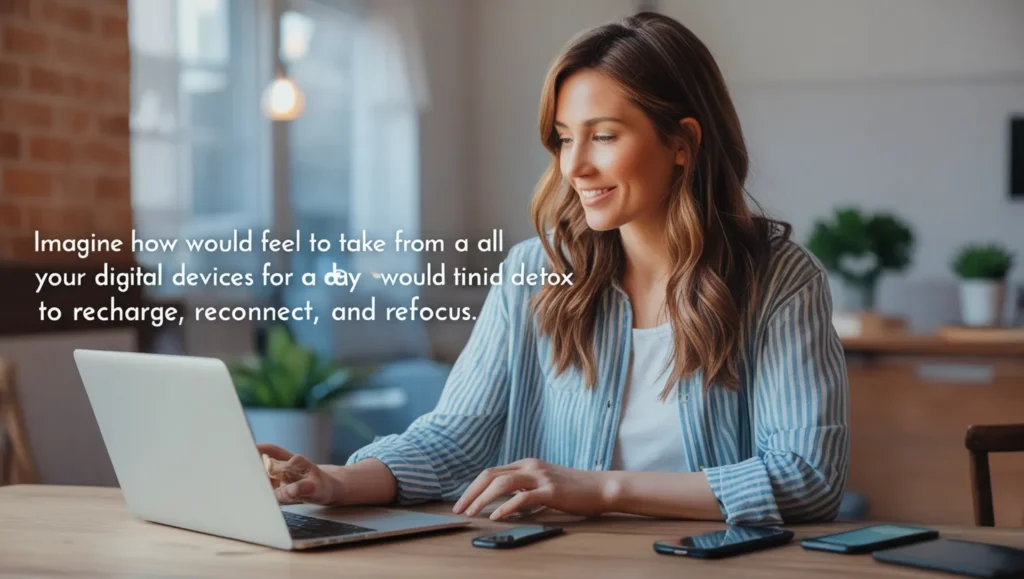Digital Detox Why and How to Unplug
In a world dominated by screens, the idea of stepping away from our devices can feel both liberating and daunting. From smartphones and laptops to social media and streaming platforms, technology is deeply woven into the fabric of our lives. While it brings convenience and connectivity, it also presents challenges, such as digital burnout, decreased productivity, and strained mental well-being.
This is where the concept of a digital detox comes in—a deliberate break from digital devices to recharge and reconnect with yourself and the world around you. In this blog, we’ll delve into why a digital detox is essential, the signs that you may need one, and practical tips to help you unplug effectively.
Why Consider a Digital Detox?
Excessive screen time has far-reaching impacts on both mental and physical health. Here’s why taking a break from your digital life is worth considering:
- Improved Mental Health
Constant notifications and endless scrolling can increase stress, anxiety, and feelings of overwhelm. A digital detox allows your mind to rest and reset. - Better Sleep Quality
Blue light emitted by screens disrupts your sleep patterns, making it harder to fall and stay asleep. Unplugging, especially before bedtime, can lead to more restful nights. - Enhanced Focus and Productivity
Digital distractions often hinder our ability to concentrate. Taking a break can help you regain focus and complete tasks more efficiently. - Strengthened Relationships
Too much screen time can weaken real-world connections. A digital detox encourages meaningful interactions with friends and family. - Physical Health Benefits
Prolonged screen use can lead to eye strain, neck pain, and a sedentary lifestyle. Stepping away promotes better posture and increased physical activity.
Signs You Might Need a Digital Detox
- You feel anxious or stressed when you’re away from your phone.
- You often lose track of time while scrolling through social media.
- You struggle to focus on tasks without checking your devices.
- You experience sleep disturbances, such as trouble falling asleep.
- You’ve noticed a decline in your relationships or social interactions.
Preparing for a Digital Detox
A successful digital detox requires planning and intention. Here are steps to get started:
- Set Clear Goals
Define why you want to unplug. Is it to reduce stress, improve productivity, or spend more quality time with loved ones? - Choose the Scope
Decide whether you’ll take a complete break from all devices or limit your detox to certain apps or platforms, like social media. - Establish a Timeframe
Start small, such as a few hours or a day, and gradually increase the duration of your detox. - Inform Others
Let your friends, family, or colleagues know about your detox to manage their expectations and gain their support. - Create a Plan for Idle Time
Plan offline activities like reading, exercising, cooking, or spending time outdoors to fill the void left by digital devices.
How to Unplug Effectively
- Designate Device-Free Zones
Establish areas in your home, such as the bedroom or dining room, where screens are not allowed. - Use Digital Detox Tools
Many apps and devices offer features to help you disconnect, such as screen time tracking, app blockers, and focus modes. - Turn Off Notifications
Silence non-essential notifications to reduce the urge to check your phone. - Replace Digital Habits with Healthy Alternatives
Swap screen time for activities like journaling, meditation, or hobbies that bring you joy. - Reconnect with Nature
Spend time outdoors to rejuvenate your mind and body while enjoying the benefits of fresh air and natural surroundings. - Reflect and Reassess
After your detox, take time to evaluate its impact and adjust your digital habits accordingly.
The Benefits of a Digital Detox
- Renewed Clarity and Creativity
Disconnecting from digital distractions can spark new ideas and enhance problem-solving abilities. - Improved Relationships
Being fully present strengthens bonds with loved ones and fosters deeper connections. - Increased Energy Levels
Reduced screen time can combat mental fatigue, leaving you feeling more energetic and engaged. - Greater Self-Awareness
A digital detox allows you to reflect on your habits and prioritize what truly matters in your life.
Challenges of a Digital Detox and How to Overcome Them
- Fear of Missing Out (FOMO)
It’s natural to worry about missing updates, but remind yourself that the world will still be there when you return. - Boredom
Idle moments might feel uncomfortable at first. Keep a list of offline activities to stay engaged. - Work Commitments
If work requires digital connectivity, schedule a partial detox by limiting personal screen use during non-working hours.
Post-Detox: Building Healthy Digital Habits
After completing your detox, adopt sustainable habits to maintain balance:
- Schedule Screen-Free Time: Dedicate specific hours each day to being offline.
- Practice Mindful Technology Use: Be intentional about when and why you use digital devices.
- Curate Your Digital Space: Unfollow accounts or delete apps that don’t add value to your life.
- Limit Multitasking: Focus on one task at a time to enhance productivity and reduce stress.
Final Thoughts
A digital detox isn’t about rejecting technology; it’s about reclaiming control over how you use it. By unplugging periodically, you can cultivate a healthier relationship with your devices and enjoy the benefits of a more balanced, mindful lifestyle.
Are you ready to take a break and experience the freedom of unplugging? Start small, stay consistent, and watch as your life transforms in ways you never imagined. The digital world will wait—but your well-being can’t.

